
Understanding aperture
Like shutter speed, aperture is one of the
fundamental things involved in getting a correct exposure. Here’s what you need to know.
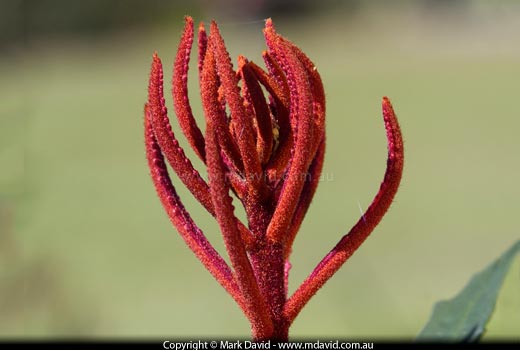
To make the new growth in this Banksia plagiocarpa stand out
I only had to blur the background away. And I did that by using a big aperture.
What is it?
The aperture setting is the one that determines the size of the hole in your lens.
The bigger the aperture the bigger the hole, which means more light gets into your
camera and so your images end up brighter.
But first …
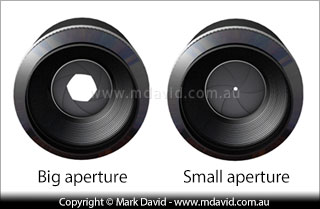
The aperture setting controls the size of the hole letting light into the lens.
This article assumes you’re starting to venture beyond the Auto settings of
your camera. Because if you work in Auto mode, your camera makes all of the
aperture decisions for you.
f-stops
Aperture settings are described as f-stops or f-numbers. That
might seem just plain weird, but there’s a really good reason for it, and I
explain it in my article on getting started in
digital SLR photography. Also, a small f-number (such as f/1.4) represents
a big aperture (a big hole), and a big f-number (such as f/22) represents a
small aperture (a small hole). Why does the big represent the small? Rather
than repeat myself here, you can find that explained too on that page about getting started
with Digital SLR photography.
Stops
Sometimes photographers talk about ‘stops’. For example, when they’re
talking about exposure compensation they might want
to go up or down a stop.
A stop can be thought of as a unit of aperture. Huh? Okay, then think of it this way:
if you increase your aperture by one stop then you’re doubling how much
light gets onto your sensor. Go down a stop, and you’re halving the amount of
light.
Big apertures
Big apertures do two things:
- they let more light into the lens (making things brighter) and
- they create a reduced depth of field. That means backgrounds will be more likely
to blur away
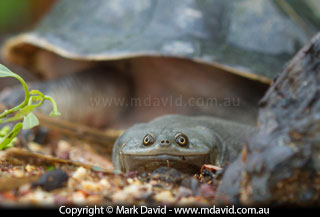
A big aperture blurred the background in this picture of a
freshwater turtle. That helped draw attention to the turtle’s face.
Small apertures
Just like you’d expect, small apertures do the opposite to big apertures:
- they let less light into the lens (making things darker) and
- they cause an increase in the depth of field. Which means backgrounds will be
more noticeable.
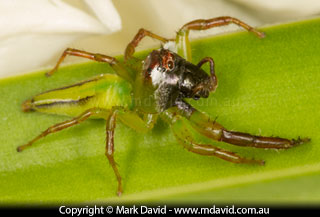
In macro photography it can be a struggle to get a whole spider in clear focus.
A small aperture increased the depth of field, which allowed most of this Northern Green Jumping spider to look nice and sharp.
Limits
Your maximum and minimum aperture (the biggest possible hole or smallest possible
hole for letting in the light) will be constrained by the mechanical limits of your
lens.
While you might want to often use your lens at its maximum (biggest) aperture,
it’s unusual to want to use your lens at its smallest aperture. That’s
because of a sneaky little problem called diffraction.
Diffraction
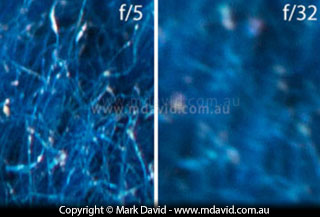
100% crops showing the same part
of the same photo taken at f/5 and f/32. Diffraction caused the fuzziness at f/32.
Very small apertures (letting the light in through a really tiny hole) cause
diffraction, which makes everything look a little bit blurry.
For that reason, I think it’s a good idea to never use an aperture smaller than
about f/16, or to put it in other words, try not to use an f-number bigger than 16.
In fact, even that’s pushing it, because in an SLR camera you’re going to
get some diffraction at f/16 too but for things like macro photography, where you often
need every bit of depth of field you can get then a little bit of diffraction is the
price you sometimes have to pay. If you really want to get cleaner shots then try not to
go for a bigger f-number than about f/10.
Weak light
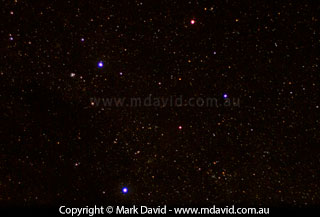
A big aperture helped capture the weak light from stars in the
night sky. This pic shows the Southern Cross.
A big aperture is handy if the light isn’t very strong. Because letting light
in through a bigger hole in the lens means more photons are captured by the sensor in
less time, which translated into photography language means shorter shutter speeds.
Those shorter shutter speeds can come in handy if your subject is moving because they
mean you’ll capture less motion blur.
How to take control of your digital SLR’s aperture
When your camera is in one of its automatic modes, it looks after the aperture
settings for you. However it’s easy to take back control of aperture if you want.
For example, you might want to manage how much depth of field you’re getting —
which is something controlled by aperture.
All you have to do is to switch your camera to aperture priority mode.
Most likely that will be done with a big dial on the camera and you select the setting
that says ‘A’ (for Aperture) or ‘AV’ (for Aperture Value, which
means the same thing).
Once you’ve done that, then your camera sticks with whatever aperture you
choose. When getting its automatic exposure right the camera will make its own adjustments
to shutter speed and maybe also to ISO. But the aperture will be whatever you decided.
If you want, you can switch to manual mode (‘M’ on the dial) and then
your camera sticks with your choices of aperture and shutter speed.
Shameless plug
So that’s aperture for you, but if you don’t properly understand how
it relates to depth of field and shutter and speed and how it fits in with why SLRs
(digital or otherwise) are such fantastic cameras, then I really urge you to read my
web page called the beginner’s guide to digital SLR photography.
Yeah I know I keep shamefully plugging that article, but the feedback I’m
getting tells me it’s actually helped an awful lot of people make sense of
their fancy new cameras. Which means you can spend less time thinking about technical
stuff and more time taking pictures. SLR cameras and the fancy new mirrorless
offerings are fantastic tools and you’ll be amazed at how capable and versatile
they are once you understand the fundamentals.

Before you start

The essential basics

Making sense of technical stuff

Photography words explained

Sneaky stuff

Common problems and their solutions

Taking things further

Photography at night
Copyright © Mark David. All rights reserved















